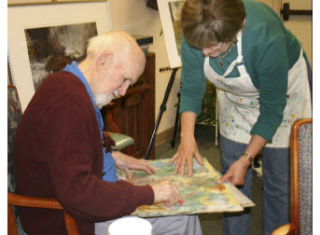Perusing the storefront gallery at Bainbridge Arts and Crafts reveals an eclectic, accessible collection of painting, textile, jewelry and glasswork. There’s usually a fun find, and with any purchase comes the warm, fuzzy feeling of knowing you’ve supported an area artist and a long-standing non-profit gallery.
If the gallery is the lovely face of BAC, though, the compact cluster of desks at the rear form the heart and brains that fulfill the mission of the operation.
There, staffers such as education director Victoria Josslin and artist demonstration coordinator Beth Moga put together outreach programs to help fulfill BAC’s original mission: give local artists and craftspeople a chance not just to sell their work, but to demonstrate to others how accessible art can be.
“We really have a strong focus on bringing art out into the community, and making it available to everyone,” Moga said.
This past January, BAC staged a 60th anniversary show titled “Whodunit,” whose proceeds were earmarked for a new program fittingly titled, “Art after 60.”
Through the effort, local artists with a flair for demonstration would visit local senior communities such as the Madison Avenue Retirement Center, Wyatt House, and the Bainbridge Island Senior Community Center.
Seniors, Moga points out, often have limited financial resources for “extras” like art. Some have reduced mobility or don’t drive. In short, it’s not so easy for some of them to cruise into Winslow and swing by a gallery, much less get out for a class.
So, inspired by a successful art demonstration series Moga coordinated at Harrison Hospital last summer, BAC set out to develop a roadshow of sorts that would put artists – everyone from painters to weavers to collage specialists – into the common areas of senior communities.
Moga has worn many hats in her life: painter, teacher, and – her bread and butter back in the Midwest – food service manager specializing in long-term senior care. “Art after 60” gave her a chance to combine her loves and interest areas. Without the food service part.
At one of the first demos, at Wyatt House this past March, Moga wasn’t sure what the residents’ response to her watercolor presentation would be.
A few people expressed initial displeasure at having their naps interrupted. But the group allowed itself to become absorbed by her presentation of landscapes-in-progress. And as Moga worked, she talked, not “at,” but “with.”
Soon, the audience and artist were engaged in a lively exchange about local places, the work that residents used to do and enjoy, and the landscapes of their memories.
“It’s a performance,” Moga said. “It is a little tricky because you have a different pace than you do in your studio. You do switch left brain and right brain. But you also learn something in the process of doing it.”
Jeannie Grisham set up her art table in the MARC’s common room on a recent Thursday. In front of an engaged crowd of 10 or so, she oversaw a collaborative painting-drawing demonstration with her attendees.
“This is a real red-red,” she told resident Bill Cassella, her chosen partner in demonstration crime. “So go ahead and be gutsy. Just do it.”
She handed him a painting-in-progress, so far an abstract study in blues, along with the vivid pinky-vermilion pastel.
He was quiet but definitive as he added bold, curving lines of hot color to the cool watercolor backdrop.
“Oh, this is fine!” he said as he handed the painting back to Grisham.
“Bill, I think you and I are going to have to work together more often,” Grisham answered.
She moved on to another painting, availing herself of all sorts of straightforward tools for applying paint, from traditional brushes to spray bottles, from kitchen scrubbies to toilet paper.
“There’s a lot of things you can use toilet paper for,” she said.
As she brought the picture to life, she described her thought process and choices out loud, noting that in painting, she uses two sides of her brain: one to maintain control for her core representational drawings, and the other to spur the exuberant abstractions that surround them.
It may seem “schizo and crazy,” she told them, but using both parts helps keep her balanced as an artist. She can be both exacting, and free.
One observer pointed out simply that Grisham really seemed to enjoy what she was doing.
“Oh, I do,” she said. “You can tell, all I advocate is just to have fun.”
At the end of the demonstration, the MARC residents asked Grisham to please come back again. The demo clicked, exactly as Moga found in her own presentation, and exactly as she’d hoped in developing “Art after 60.”
“Most people haven’t given up living – they’re still alive,” she said. “And they want to do expressive things and be vital people.”
===
Vital stats
For more information about BAC at 60 and the organization’s ongoing shows and programs, see www.bacart.org.



